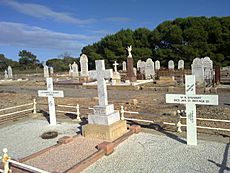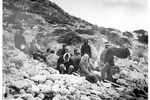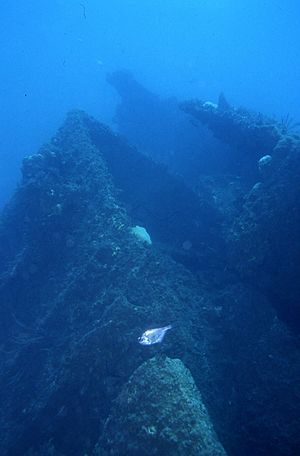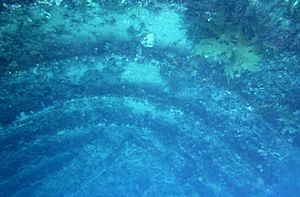SS Clan Ranald (1900) facts for kids
class="infobox " style="float: right; clear: right; width: 315px; border-spacing: 2px; text-align: left; font-size: 90%;"
| colspan="2" style="text-align: center; font-size: 90%; line-height: 1.5em;" | 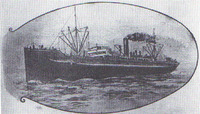
|}
The SS Clan Ranald was a special kind of ship called a turret deck ship. It sank on January 31, 1909, off the coast of Yorke Peninsula in South Australia, near the town of Edithburgh. This was the only turret ship ever lost in Australian waters. This makes its story a unique part of Australia's history at sea. Most of the crew were Asian sailors, known as lascars. The sinking of the Clan Ranald is remembered as one of the worst shipwrecks in South Australia. Only 24 people survived out of the 64 crew members.
Contents
| History | |
|---|---|
| Name | SS Clan Ranald |
| Owner | Clan Line |
| Builder | William Doxford & Sons, Sunderland, England |
| Launched | 31 July 1900 |
| Out of service | 31 January 1909 |
| Fate | Sunk by unknown cause |
| General characteristics | |
| Tonnage | 3,596 GRT, 2,285 NRT |
| Length | 355 ft (108 m) |
| Depth | 22.7 ft (7 m) |
| Installed power | Steam |
| Propulsion | Screw |
| Speed | 11 knots |
| Crew | 64 |
- Protecting the Shipwreck
- Why the Clan Ranald Site is Important
- Legal Protection of the Clan Ranald
- Images for kids
About the Clan Ranald
The SS Clan Ranald was built in 1900 by William Doxford & Sons in Sunderland, UK. It was made for the Clan Line Steamers company in Glasgow. The ship was 355 feet long and weighed 2,285 tons.
What is a Turret Deck Ship?
The turret deck ship design was quite new in the early 1900s. These ships were considered strong and good at handling rough seas. They were also cheap to run, especially for carrying large amounts of grain. The sides of a turret ship curved inward near the top. This created a ledge partway up the hull. This design helped keep the cargo tightly packed, so it wouldn't move around much during travel.
The main benefit of this design was saving money on port fees. Turret ships had a lower "tonnage" measurement, which could reduce costs by up to 10%. Also, their narrow upper deck meant lower fees when passing through the Suez Canal. Canal charges were based on the ship's deck width and its net tonnage.
The Final Journey
The Clan Ranald left Mauritius on December 24, 1908. It arrived in Port Adelaide on January 15, 1909. There, it loaded a huge amount of cargo: almost 40,000 bags of wheat and over 28,000 bags of flour. It also took on 638 tons of coal, with 170 tons placed on the top decks.
On January 31, the ship left the Semaphore Anchorage. It was heading for South Africa. Even though it was leaning a little to its right side (a 4-degree list to starboard), it set sail. There were 64 people on board. The crew included four Manilamen, sixteen Calcuttamen, and 34 Lascars. Captain A.S. Gladstone was in command.
The Shipwreck Event
At 2 PM, the ship was south of Troubridge Island when it suddenly tilted sharply to its right side, at a 45-degree angle. The crew rushed onto the deck, but the engine was still running. The right side of the deck went underwater, which made the ship's rudder lift out of the water.
At 4:30 PM, a strong wind pushed the ship towards Troubridge Hill. The rough waves had already smashed the ship's lifeboats. The vessel was driven very close to the cliffs. In a desperate attempt to escape, the crew tried to build rafts from broken pieces of the ship.
They fired distress rockets to signal for help after seeing a nearby ship, the SS Uganda. But for some reason, the SS Uganda did not come to help. At 10 PM, the Clan Ranald flipped over and sank. It went down in 20 meters of water, about 700 meters from the shore. Many crew members were pulled under as the ship sank. Others who swam to shore died when they reached the steep cliffs and sharp rocks, which were impossible to climb. Some also died from the freezing cold during the night.
Rescue and Aftermath
Even though the SS Uganda didn't respond to the distress rockets, some local people from Troubridge saw them. They quickly went to the beach and helped many of the surviving crew. The locals also searched for other survivors along the shore. They were shocked by the terrible loss of life they found. Some bodies were so badly damaged they could not be recognized.
Only 36 of the missing bodies were found. These were buried in Edithburgh Cemetery. The five British officers were buried in the main part of the cemetery. The 31 Lascar crew members were buried together in a mass grave at the back.
Survivors' Journey
At daylight, the 24 survivors were taken to Edithburgh and then to Adelaide. Four of the survivors were British, and the other 20 were lascars. The four British officers stayed at Woodcock’s Royal Arms Hotel. The lascars were placed in the basement of the Prince Alfred Sailors Home.
At that time, Australia had a rule called the White Australia policy. Because of this policy, the lascar survivors had their handprints taken. They were also given a special test designed for them to fail. This meant they were treated as illegal immigrants, even after their terrible experience. This was due to the Immigration Restriction Act 1901. Because of this, they were soon sent to Melbourne to board another ship, the Clan McLachlan, which was going to Colombo.
However, the lascar survivors were not treated badly by everyone. They received support from the people of Adelaide. While they were held, they were given food, clothing, and cigarettes. Before they left, the Mayor of Adelaide even gave each of them a gift of money and wished them well.
The Shipwreck Site Today
The Clan Ranald shipwreck site was found in 1962 by a volunteer group from the South Australian Museum. At that time, the site was in amazing condition. The wreck lies off the southern coast of Yorke Peninsula. It is about 14 kilometers southwest of Edithburgh and 1.25 kilometers west of Troubridge Hill. The exact location is 35°10′3.7″S 137°37′14.8″E / 35.167694°S 137.620778°E.
What the Wreck Looks Like Underwater
Soon after the sinking, a diver named C. Olsen inspected the Clan Ranald. He found that the ship was lying on its right side. The top of the turret deck was on the seabed, and the left side of the hull stood up. The ship was almost upside down on the ocean floor.
A report from 1909 said: "The highest part of the ship is her port bilge [left side] keel. The starboard [right side] bilge keel is about 9 feet off the bottom. The starboard top sides and the top of the turret had sunk some distance in the sand. There is a lot of coal scattered to the east of the ship."
The Clan Ranald lies in an east-southeast to north-northwest direction, with its front (bow) pointing east-southeast.
Today, many parts of the Clan Ranald still remain. Most of the hull has fallen apart. But a section is still held up by the left side boiler. The double-layered bottom of the bow stands upright. The bow section has collapsed forward and downward into two pieces. There are still huge boilers on the site. They are about 2-3 times the size of a diver and are an amazing sight for visitors. The left main boiler has rolled out and is separate from the hull. Underneath the collapsed hull, the engine is still mostly in one piece.
Other interesting things at the site include:
- The Propeller: It is still there. However, people illegally using explosives damaged and removed its blades. The propeller shaft can still be seen under the collapsed hull.
- At the bow area, the windlass (a machine for lifting anchors) and a large pile of chain remain.
- The rudder (used for steering) is also on site. It has come off the back (stern) of the ship, possibly because of explosives used to remove the propeller blades.
- The highest part of the wreck is 6 meters above the seabed. This includes the left bilge keel and the double bottom hull, which rests on the right main boiler.
Condition of the Site
Even with a lot of wreckage, the Department of Environment and Water (DEW) says the site is "poorly preserved." This means the hull is still mostly intact up to a certain point. But the frames and outer plates of the hull have collapsed. The front (bow) and back (stern) might still be intact. The ship's boilers or engines are still in their original places.
Protecting the Shipwreck
Protecting a shipwreck site depends on how much danger it faces. This can be from people interacting with the site or from natural things like water currents. The DEW report on the Clan Ranald site pointed out these risks:
- Human impacts: High risk. There are still ship parts and personal items from the crew that could be stolen. Also, damage from dragging anchors is very likely.
- Natural impacts: Low risk. The environment around the site is quite stable. However, the large, upright parts, like pieces of the bow and stern, and the wreckage around the boilers, are at higher risk of breaking down. Illegal stealing and salvage have destroyed large parts and made the site decay faster.
The wreck has gotten worse in recent years. This is due to damage from boat anchors and also fewer fish in the area because of too much fishing.
Why the Clan Ranald Site is Important
The Clan Ranald is one of the most tragic and special shipwrecks in Australian waters. It is remembered as one of Australia's worst shipwrecks, with many lives lost. The graves of the officers and crew in the nearby Edithburgh Cemetery are a sad reminder of this huge tragedy.
The wreck site and the event itself are very important to the community of the lower Yorke Peninsula. Not only because of the terrible loss of life, but also because the locals played a big part in helping the survivors. Even today, if you visit the graves, you can see fresh flowers there.
Here is a poem written about the shipwreck:
The Wreck of the "Clan Ranald"
Down the Port River, on a mid-summer day The steamer, Clan Ranald, swept proudly away. Bound for the Cape, with a light-hearted crew What was in store for them God alone knew.
At ‘four bells’ she was struck by a big angry sea, She listed right over; her decks washed a-lea. She was crippled — and signalled for help to the shore, But ere it arrived the ship was no more.
Down went the Clan Ranald, a most sad disaster, For forty poor souls were called to their Master. Rescuers on shore all help they were giving, They were risking their lives for the sake of those living.
For, in utter darkness they were battling that night In surf they were rushing to save, black and white. Let us pity those living, and pray for those still, Who were washed to Eternity off Troubridge Hill.
Archibald Deacon, 1909
The remains of the ship offer a fascinating dive for anyone who visits the site. The large boilers and parts of the bow and stern make for a unique and interesting dive. The remains are clear enough that you don't need to know much about the ship to understand what you are seeing. Plus, the site is great for diving because of all the marine life and interesting features.
- Dive Information*
- Depth: 18 meters
- Visibility: 10 meters
- Bottom Type: Sand
- Best Diving time: February–April, when winds blow from the north.
Studying the remains of the Clan Ranald is useful because this type of ship, the turret deck ship, was unusual and only used for a short time. This study is possible because of how well the remains and visible parts of the ship are preserved on the site.
Archaeological studies of the personal items left at the site could tell us a lot about the lives of British sailors, who were often overlooked. Also, comparing the officers and the mostly Lascar crew would be interesting. This could be compared to other famous shipwrecks, like the Sydney Cove, which also had a mostly Indian crew.
Legal Protection of the Clan Ranald
The Clan Ranald was found in 1962 by the South Australian Museum Underwater Research Group. This group then bought the remains from the Clan Line of Steamers in London. They bought the wreck to stop divers from taking things from the site and to slow down its decay. In 1988, ownership was given to the South Australian Government.
The Clan Ranald is protected by a law called the Commonwealth Historic Shipwrecks Act 1976. This means the site and all items found there are considered historic and are protected. It is illegal to remove any items or damage the site.
The wreck is also located within a protected marine area called the Troubridge Hill Aquatic Reserve. This area, about 4 square kilometers, was set up in 1983. This gives the wreck site extra protection, as it is against the rules to remove marine life from its surfaces or the nearby seabed.
Most importantly, the Clan Ranald is a key part of the DEW Investigator Strait Shipwreck Heritage Trail. This means that, along with other important shipwrecks, the Clan Ranald is promoted to the public. This helps teach people about the importance of Australia's historical shipwrecks.
Images for kids
-
Huddart, Parker's coastal passenger ship Riverina took the surviving lascars from Port Adelaide to Melbourne


